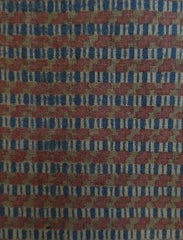A Length of Taisho/Showa Era Stenciled Cloth: Vague Allusion to Indian Cotton
early twentieth century
41" x 14", 104 cm x 35.5 cm
Throughout centuries of Japan's history the upper classes admired and collected Indian trade cloth which they referred to as sarasa. Some of it they commissioned directly from India, specifying certain patterns a colors to be used while other pieces were purchased directly from India and showed traditional Indian patterns.
The Japanese admired sarasa so much that they started making their own cloth that suggested the original.
In the early twentieth century cloth of Japanese manufacture that was evocative of Indian trade cloth--but more in keeping with Japanese taste--became popular. However it was designed in different patterns and in different colors than the Indian inspiration and this piece is an example.
You can see this in the restrained pattern, the subdued colors of similar value and the hand made look of the design, all quite beautiful.
The cotton is machine loomed, lightweight and it does not have one of its selvedges.
The imperfection of the dyeing of the piece is charming as is how this type of cloth fits into Japan's early twentieth century popular culture.
Lovely--and more interesting than it might appear.


